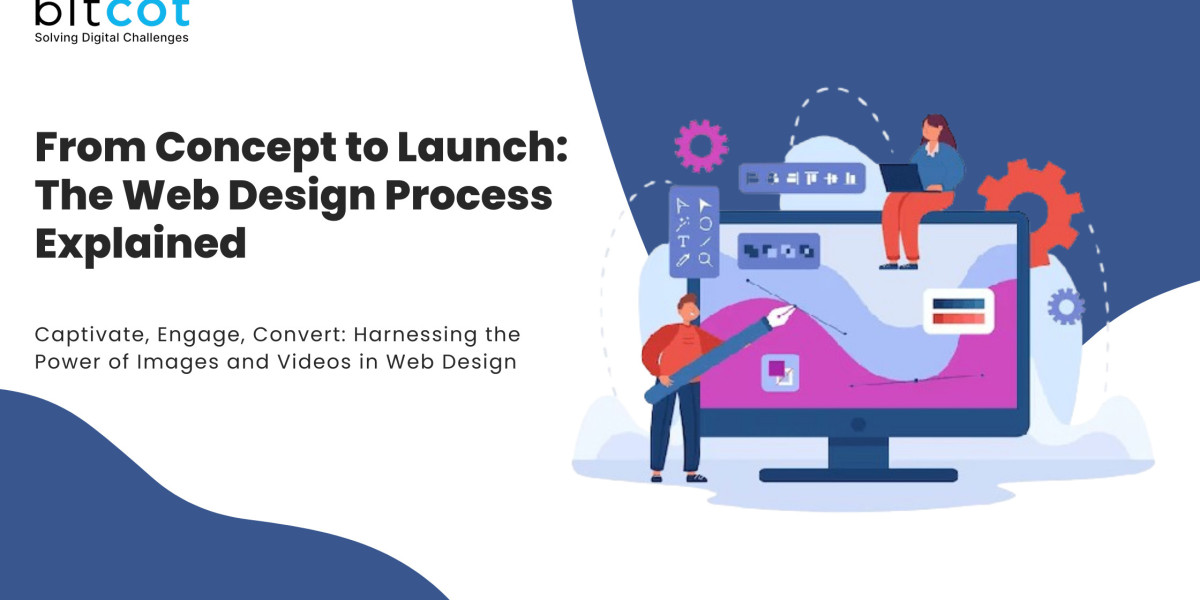Creating a website is an intricate process that involves careful planning, creativity, and technical expertise. A well-designed website can significantly enhance your online presence, engage visitors, and drive conversions. Whether you’re a business owner, a designer, or a developer, understanding the web design process from concept to launch is crucial. In this blog, we’ll walk you through the key stages of web design, providing insights and tips to ensure a successful project.
- Discovery and Research
The web design process begins with discovery and research. This stage is all about understanding the project’s goals, target audience, and competitive landscape.
Client Goals:
Meet with the client to discuss their objectives, brand identity, and desired functionalities. This helps in defining the scope of the project and setting clear expectations.
Audience Analysis:
Identify the target audience and their needs. Understanding user behavior and preferences is crucial for creating a user-centric design.
Competitive Analysis:
Analyze competitors’ websites to identify strengths, weaknesses, and opportunities. This helps in differentiating your design and finding inspiration for features and functionalities.
- Planning and Strategy
With a clear understanding of the project’s goals and audience, the next step is planning and strategy. This stage involves creating a blueprint for the website.
Site Map:
Develop a site map that outlines the structure and hierarchy of the website. It should include all the main pages and subpages, ensuring a logical flow of information.
Wireframes:
Create wireframes to map out the layout and structure of individual pages. Wireframes are simple, black-and-white sketches that focus on the placement of elements without getting into design details.
Content Strategy:
Plan the content for each page. Determine what type of content (text, images, videos) will be needed and how it will be organized. This stage may involve working with content writers and strategists.
- Design
Once the planning phase is complete, it’s time to move on to the design stage. This is where the visual aspects of the website come to life.
Visual Style:
Establish a visual style that aligns with the brand’s identity. This includes selecting colors, typography, and imagery that reflect the brand’s personality and appeal to the target audience.
Mockups:
Create high-fidelity mockups of the key pages. These mockups are detailed visual representations of the final design, showing colors, fonts, images, and other design elements.
User Experience (UX) Design:
Focus on creating a user-friendly experience. Ensure that the design is intuitive, with clear navigation and a logical flow. Consider accessibility and make sure the site is usable for people with disabilities.
- Development
With the design approved, the next step is development. This is where the design is translated into a functional website.
Front-End Development:
Convert the design mockups into HTML, CSS, and JavaScript. This involves coding the visual elements and ensuring they work across different browsers and devices.
Back-End Development:
Develop the server-side functionality, such as databases, authentication systems, and content management systems (CMS). This stage may involve setting up a CMS like WordPress or developing custom solutions.
Responsive Design:
Ensure the website is responsive, meaning it works well on all screen sizes and devices. This involves testing and adjusting the design to ensure a seamless experience on desktops, tablets, and smartphones.
- Testing and Quality Assurance
Before launching the website, thorough testing and quality assurance are essential to ensure everything works as expected.
Functionality Testing:
Test all interactive elements, such as forms, buttons, and links, to ensure they work correctly. Check for any broken links or errors.
Performance Testing:
Assess the website’s load time and performance. Optimize images, scripts, and other elements to ensure fast loading times.
Cross-Browser Testing:
Verify that the website functions correctly across different browsers (Chrome, Firefox, Safari, Edge) and operating systems.
Responsive Testing:
Test the website on various devices and screen sizes to ensure it’s fully responsive and user-friendly.
Accessibility Testing:
Ensure the website meets accessibility standards (e.g., WCAG) to provide a usable experience for all users, including those with disabilities.
- Launch
Once testing is complete and any necessary adjustments have been made, it’s time to launch the website.
Pre-Launch Checklist:
Perform a final review to ensure everything is in place. Check for any last-minute issues and ensure all content is up-to-date.
Deployment:
Move the website from the staging environment to the live server. This involves configuring domain settings, setting up hosting, and ensuring all files are correctly uploaded.
Post-Launch Monitoring:
Monitor the website closely after launch to ensure everything is working smoothly. Address any issues that arise and make necessary updates.
- Maintenance and Updates
The web design process doesn’t end with the launch. Ongoing maintenance and updates are crucial for keeping the website relevant and functional.
Content Updates:
Regularly update the content to keep it fresh and relevant. This may involve adding new blog posts, updating product information, or making seasonal changes.
Security Updates:
Ensure the website is secure by keeping software, plugins, and scripts up-to-date. Implement security measures to protect against threats.
Performance Monitoring:
Continuously monitor the website’s performance and make improvements as needed. This includes optimizing load times, fixing bugs, and improving user experience.
Conclusion
Designing a website is a complex process that requires careful planning, creativity, and technical expertise. By following these stages—from discovery and research to maintenance and updates—you can create a website that not only looks great but also meets the needs of your users and achieves your goals. Remember, a successful website evolves and improves over time, so stay committed to ongoing enhancements and updates.
Also Read: 15 Best Web Application Design Examples for Inspiration



